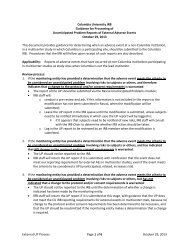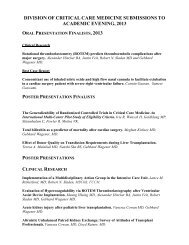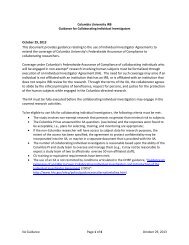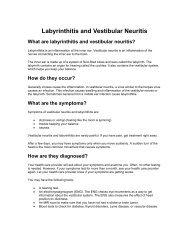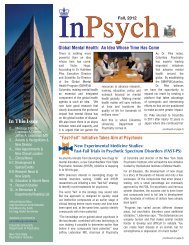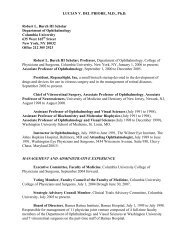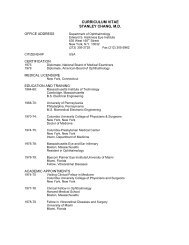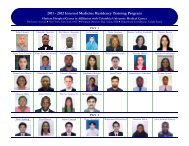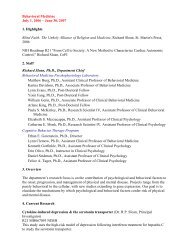news PS - Columbia University Medical Center
news PS - Columbia University Medical Center
news PS - Columbia University Medical Center
Create successful ePaper yourself
Turn your PDF publications into a flip-book with our unique Google optimized e-Paper software.
<strong>Columbia</strong> Joins in Development of New York Genome <strong>Center</strong><br />
The New York Genome <strong>Center</strong> in November 2011 announced the development<br />
of what will become one of the largest genomic medicine facilities<br />
in North America, involving <strong>Columbia</strong>, NewYork-Presbyterian Hospital,<br />
and nine other top academic medicine and research institutions. The City<br />
of New York and private funding from corporations and foundations also<br />
support the independent, non-profit consortium, which is expected to reach<br />
more than 10 million patients as gene-based medicine grows in importance.<br />
The goal of the center is to accelerate progress toward an era of<br />
genomic research and to have an impact on patient care and clinical outcomes<br />
by leveraging the combined scientific breadth, diversity of patient<br />
population, access to clinical outcomes data, and scale of basic and clinical<br />
research among the 11 member institutions.<br />
“Completion of the human genome project and recent breathtaking<br />
technological advances in DNA sequencing and computer hardware provide<br />
an unparalleled opportunity to advance basic medical science, drug<br />
discovery, and healthcare delivery,” says Thomas Maniatis, Ph.D., the<br />
Isidore S. Edelman Professor of Biochemistry and chair of biochemistry<br />
& molecular biophysics at P&S. “The New York Genome <strong>Center</strong> will<br />
provide the opportunity for basic scientists and physicians from extraordinary<br />
universities, research institutions, and hospitals to work together<br />
to transform the complexity of genomic information into an understanding<br />
and treatment of human diseases.”<br />
The New York Genome <strong>Center</strong> is expected to open a 120,000-squarefoot<br />
facility, to be located in Manhattan, that will offer access to<br />
large-scale but cost-effective gene sequencing, data mining, and leading<br />
edge instrumentation. The center will offer an initial technology platform<br />
of next-generation sequencers and will scale up to be fully operational<br />
within a year. The facility will house laboratory space for principal<br />
investigators, sequencing instrumentation, robotics for high-throughput<br />
library preparation, IT storage hardware for buffering and final data storage,<br />
bioinformatics, and computational capabilities. The goal is to create<br />
the largest high-throughput gene sequencing facility for translational<br />
research of its kind in North America.<br />
The New York Genome <strong>Center</strong> facility<br />
shown in this rendering will open in<br />
Manhattan in early 2013. The location<br />
will be announced later this year.<br />
Other collaborating institutions are Cold Spring Harbor Laboratory, Weill<br />
Cornell <strong>Medical</strong> College, Memorial Sloan-Kettering Cancer <strong>Center</strong>, Mount<br />
Sinai <strong>Medical</strong> <strong>Center</strong>, NYU School of Medicine, North Shore-LIJ Health<br />
System, the Jackson Laboratory, Rockefeller <strong>University</strong>, and Stony Brook<br />
<strong>University</strong>. The Hospital for Special Surgery is an associate founding member.<br />
At <strong>Columbia</strong>, the Judith P. Sulzberger <strong>Columbia</strong> Genome <strong>Center</strong>, directed<br />
by Andrea Califano, Ph.D., professor of systems biology and biochemistry<br />
& molecular biophysics, will be a key scientific and technological partner<br />
for the New York Genome <strong>Center</strong>. The Sulzberger <strong>Center</strong> has developed a<br />
large-scale infrastructure for the analysis of genomic sequences, especially<br />
in the context of recent advances in systems biology approaches. It also<br />
has developed significant capabilities in next generation sequencing, highthroughput<br />
screening, and high-throughput, high-content microscopy to<br />
advance the technology available for genomics research and to address<br />
important problems in biological and biomedical research.<br />
“It is critical that the genome centers of the individual NYGC member<br />
institutions work collaboratively to develop the leading edge of sequencing<br />
technology and analysis. Each of the institutions has specific strengths<br />
and know-how that would be hard to reproduce within a single organization.<br />
When this is combined with the throughput and scientific reach<br />
of the NYGC, this makes all of us more competitive and better able to<br />
recruit key genomic faculty to New York City,” says Dr. Califano. “I<br />
expect New York to experience a true renaissance in the genomic sciences<br />
thanks to this initiative.”<br />
“The New York Genome <strong>Center</strong> will make it possible to share extraordinarily<br />
rich and diverse data on an unprecedented scale and allow us to<br />
support the world’s premier research and medical institutions, as well<br />
as their diagnostic and pharmaceutical partners,” says Nancy J. Kelley,<br />
founding executive director. “NYGC will be a powerful engine for breakthrough<br />
genomic science, as well as for commercial development, in the<br />
New York region.”<br />
Dr. Maniatis is a member of the center’s executive committee. Lee<br />
Goldman, M.D., EVP and dean, is a member of the Board of Directors.<br />
Spring 2012 <strong>Columbia</strong>Medicine 7



